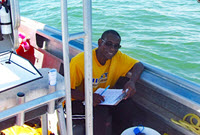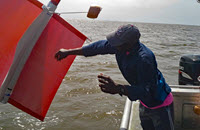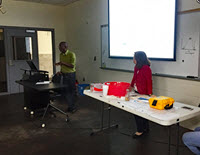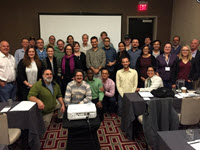
Oil spill material that enters the water column may adhere to resuspended seafloor sediments and be transported to other areas. Stephan O’Brien is investigating how physical factors, such as wind and waves, affect the suspension and subsequent transport of sediments in the Mississippi Sound and Bight. “Inorganic matter such as sediment is one of the methods by which oil can be transported,” said Stephan. “By improving our understanding of sediment dynamics, we can provide first responders with information that can help them interpret how moving sediment may affect oil transport.”
Stephan is a Ph.D. student at the University of Southern Mississippi’s Division of Marine Science and a GoMRI Scholar with the Consortium for Oil Spill Exposure Pathways in Coastal River-Dominated Ecosystems (CONCORDE).
His Path

Stephan’s brother chose a scientific path in high school, sparking Stephan’s interest in science. Schools in Stephan’s home of Trinidad and Tobago follow the British system, where students choose a focus such as arts or sciences when they enter high school. Then they narrow that focus to a more specific field during their final two years before entering university studies. When he was 14, Stephan followed his brother’s example and chose math, physics, chemistry, and biology as his primary focuses and later narrowed his scope to math and physics.
As an undergraduate at the University of the West Indies, Stephan discovered his interest in hydrography after taking two hydrography classes. Later, he applied to the University of Southern Mississippi and started studies in their Hydrographic Science master’s program. His final master’s project was planned to be a survey of Bay St. Louis, Mississippi, in summer 2010. However, his intended survey region was closed following the Deepwater Horizon oil spill, and Stephan moved his survey to Pearl River, Mississippi.

Stephan returned to Trinidad and Tobago to teach at the University of the West Indies. While there, he realized that his island was suffering from coastal erosion. This realization inspired him to return to the University of Southern Mississippi as a Ph.D. student to research sediment movement. While working with his advisor Dr. Jerry Wiggert, their team became a part of the CONCORDE research group investigating sediment movement and its relationship to oil transport. “There is a lot of erosion that occurs along the eastern coast of our island country because of the wave action,” said Stephan. “Just being aware of that problem helped with the decision of what I’d like to do for my Ph.D.”
His Work
Focusing on the Mississippi Sound and Mississippi Bight, he analyzes NASA’s remote sensing reflectance data () and uses an algorithm to estimate surface sediment concentrations. He filters surface water samples collected at the same time and location to quantify suspended sediment concentrations and uses an in situ optical back-scatter instrument called a Laser In-Situ Scattering and Transmissiometry (LISST) to measure particle sizes.

Stephan uses the in situ suspended sediment concentrations to ground truth the accuracy of a numerical model (Coupled-Ocean-Atmosphere-Wave-Sediment transport model) that characterizes how water masses move within the study domain. Particle sizes can be varied in the model and forcing factors such as wind or wave action can be varied and/or removed from the simulation. This allows Stephan to analyze how each forcing factor changes over time and how each environmental factor contributes to the direction and volume of sediment transported within each sediment size class. “The numerical model is similar to a weather forecast,” he explained. “While weather forecasts use measurements to describe weather patterns over time, this numerical model uses water column and atmospheric measurements to describe how different physical factors affect ocean current movements and, as a result, how much and in which direction sediment will be transported.”
Stephan’s preliminary observations show elevated in situ sediment and increased salinity in Spring 2016, suggesting a link between shoreward advection from the continental shelf and subsequent sediment resuspension. However, Stephan’s model results suggest that the environmental factors driving sediment resuspension and transport in Spring 2016 originated from Lake Borgne and moved east to the Mississippi Bight rather than originating from the continental shelf as initially hypothesized.
His Learning
Stephan considers himself a “scientist-in-training,” and his work with researchers from different backgrounds has helped him learn other research techniques. During the consortium’s spring 2016 cruise, he conducted research alongside Naval Research Laboratory scientists, who showed him how to operate an optical sensor. “Although it was not the same optical instrument I was using to collect my samples, getting to know the details about the sensor helped me get a better understanding of the measurements I was taking in the Sound,” he said.
His Future
Stephan hopes to find a post-doc position with a strong focus on sediment transport, perhaps in Holland or Germany, to gain additional research experience before returning home. He hopes to apply his research skills and experience towards addressing Trinidad’s and Tobago’s coastal erosion problem with Trinidadian government agencies.
His suggestion to students who are interested in science is to speak with other researchers/scientists to get a better understanding of what their fields entail. They should consider gaining some experience through internships or volunteer positions to get a better understanding of actual scientific jobs. “Science is so broad – once you get experience, you can see the different scientific avenues available,” he said.
Praise for Stephan
Wiggert believes that Stephan’s personality and temperament are best captured by the concept of “quiet competence.” He praised Stephan’s diligent, self-motivated, and hard-working approach to his research, which helped Stephan develop a diverse set of observational, programming, and data management skills during his dissertation work. Wiggert also praised Stephan’s determination to share his science, explaining that he has been extremely active in presenting his research findings at scientific meetings and participating in community outreach.
The GoMRI community embraces bright and dedicated students like Stephan O’Brien and their important contributions. The GoMRI Scholars Program recognizes graduate students whose work focuses on GoMRI-funded projects and builds community for the next generation of ocean science professionals. Visit the CONCORDE website to learn more about their work.
************
The Gulf of Mexico Research Initiative (GoMRI) is a 10-year independent research program established to study the effect, and the potential associated impact, of hydrocarbon releases on the environment and public health, as well as to develop improved spill mitigation, oil detection, characterization and remediation technologies. An independent and academic 20-member Research Board makes the funding and research direction decisions to ensure the intellectual quality, effectiveness and academic independence of the GoMRI research. All research data, findings and publications will be made publicly available. The program was established through a $500 million financial commitment from BP. For more information, visit https://gulfresearchinitiative.org/.
© Copyright 2010-2018 Gulf of Mexico Research Initiative (GoMRI) – All Rights Reserved. Redistribution is encouraged with acknowledgement to the Gulf of Mexico Research Initiative (GoMRI). Please credit images and/or videos as done in each article. Questions? Contact web-content editor Nilde “Maggie” Dannreuther, Northern Gulf Institute, Mississippi State University (maggied@ngi.msstate.edu).
